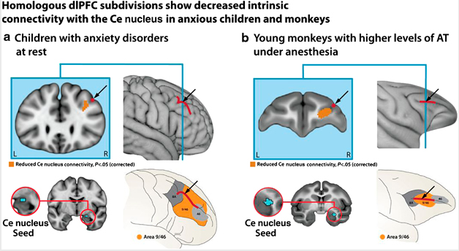A group of collaborators, mainly at the University of Wisconsin, including Ned Kalin and Richard Davidson, provide new information about the evolutionarily conserved brain network underlying extreme early-life anxiety:
Some individuals are endowed with a biology that renders them more reactive to novelty and potential threat. When extreme, this anxious temperament (AT) confers elevated risk for the development of anxiety, depression and substance abuse. These disorders are highly prevalent, debilitating and can be challenging to treat. The high-risk AT phenotype is expressed similarly in children and young monkeys and mechanistic work demonstrates that the central (Ce) nucleus of the amygdala is an important substrate. Although it is widely believed that the flow of information across the structural network connecting the Ce nucleus to other brain regions underlies primates’ capacity for flexibly regulating anxiety, the functional architecture of this network has remained poorly understood. Here we used functional magnetic resonance imaging (fMRI) in anesthetized young monkeys and quietly resting children with anxiety disorders to identify an evolutionarily conserved pattern of functional connectivity relevant to early-life anxiety. Across primate species and levels of awareness, reduced functional connectivity between the dorsolateral prefrontal cortex, a region thought to play a central role in the control of cognition and emotion, and the Ce nucleus was associated with increased anxiety assessed outside the scanner. Importantly, high-resolution 18-fluorodeoxyglucose positron emission tomography imaging provided evidence that elevated Ce nucleus metabolism statistically mediates the association between prefrontal-amygdalar connectivity and elevated anxiety. These results provide new clues about the brain network underlying extreme early-life anxiety and set the stage for mechanistic work aimed at developing improved interventions for pediatric anxiety.

Homologous dorsolateral prefrontal cortex (dlPFC) subdivisions show decreased intrinsic connectivity with the central (Ce) nucleus in anxious children and monkeys. (a) Children with anxiety disorders at rest. Bottom-left panel shows the Ce nucleus seed (cyan in red ring). Upper-left panel depicts a coronal slice through the human dlPFC cluster (dark orange; corrected for the combined volume of the mPFC and right dlPFC; n.s. when corrected for the volume of the whole brain). The intermediate frontal sulcus (IFS) is shown in dark red. Upper-right panel shows the IFS with the location of the coronal slice indicated by the blue vertical line. Bottom-right panel shows the location of the dlPFC cluster relative to the architectonic subdivisions of the human dlPFC. (b) Young monkeys with high levels of anxious temperament (AT) under anesthesia. Conventions are similar to a; dark red indicates the location of the sulcus principalis. The bottom-right panels of this figure were adapted with permission from Badre and D'Esposito.74 L, left hemisphere; R, right hemisphere.

